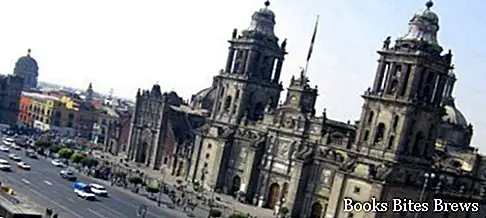What to see in Mexico City, itinerary including the main monuments and places of interest, from the square of the three cultures to the cathedral, up to the Basilica of Guadalupe.
Tourist information
Capital of Mexico at 2300 meters above sea level, Mexico City is located in the place where the Aztecs founded the city of Tenochtitlan, in the center of Lake Texcoco.
In Mexico City, there are many interesting places to see, including museums, archaeological sites, historic buildings and crowded markets, which can keep any visitor who wishes for months busy.
The main meeting place is Piazza della Costituzione, where the Cathedral and the magnificent National Palace overlook.
To know the history of the city and the nation, a visit to the Museum of Anthropology, particularly rich in documentation, is recommended, while for fun the Zona Rosa is recommended, where there are restaurants and clubs in large numbers.
What see
Piazza delle tre culture, located in the center, owes its name to the different eras of the buildings that surround it.
The first culture is that of Tenochtitlan, dating back to the period prior to the conquest of Mexico by the Spaniards, visible in the remains of the ancient Aztec city, the second culture is the Spanish one, represented by the Cathedral of Santiago and a convent, erected in colonial, the third culture is that of today's Mexico, testified by the modern building of the Ministry of Foreign Affairs.
Constitution Square, which is one of the main attractions of the city, is the main square in the historic center and the second largest in the world after the Red Square in Moscow.
In the center of the paved pavement of the square there is a large decoration representing the Mexican flag.
Piazza della Costituzione is considered the heart of the city, where major events, parties and protests are held, a good starting point to start your visit to the city.
The Metropolitan Cathedral, huge in size and located on the north side of the Zocalo, was built over a period of 250 years, combining various architectural styles.
Recommended readings- Mexico: useful information
- Puerto Escondido (Mexico): what to see
- Mazatlan (Mexico): what to see and do
- La Paz (Mexico): what to see and do
- Acapulco (Mexico): what to see
The cathedral is slowly sinking into the ground, as well as other buildings located in the historic center, which is why a major engineering project has been put in place to safeguard these ancient buildings.
The National Palace, which is located in the Constitution square and is the seat of the government, was built in 1563 on the ground where the house of Hernán Cortés stood, built in 1523.
Originally housing the viceroy, it was initially inhabited by Luis de Velasco, the second viceroy of New Spain, while later the palace was renovated to house the court and prison.
The main attraction is represented by the murals by Diego Rivera, which depict thousands of years of Mexican history.
The Templo Mayor, which was the main temple of Tenochtitlan, the ancient name of Mexico City, which was the capital of the Aztec empire.
Its construction began in 1337 and the shape was that of a pyramid with a vertical development of 60 meters in height and function of support to the two temples positioned at the top, dedicated to the gods Huitzilopochtli and Tlaloc, which were considered by the Aztecs to be an expression of equal divine omnipotence. .
It was finished in 1487, a date testified by the plaque placed in ancient times to adorn the perimeter walls.
The temple of Huitzilopochtli, which was the god of war and sun, was placed on the left and painted red.
According to mythology, men who died in battle and women who died during childbirth had to go to serve Huitzilopochtli in his temple, as a privilege for those who, having suffered so much in life, were the only ones considered worthy to see him.
In a later period, they could come back to life in the form of butterflies or hummingbirds.
The Temple of Tlaloc, dedicated to the god of rain and fertility, was located on the right and painted blue.
Tlaloc was a divinity much feared by the Aztecs, who held him responsible for the floods that occurred in the city and the sad drownings that followed.
Before making sacrifices to honor him, the tears of the sacrificial victims were poured into a special container and given on offer to the feared god.
This temple was almost entirely destroyed during the invasion of the city, which took place in 1521 by the conquistadors led by Hernán Cortés.
In 1978 the workers of the excavation electric companies next to the Cathedral brought to light a large round stone depicting the Aztec moon goddess Coyolxauqui.
The Palace of Fine Arts is a grandiose theater built in 1910 to commemorate the centenary of Mexico's independence.
It contains some murals by Diego Rivera, José Clemente Orozco, David Alfaro Siqueiros and Rufino Tamayo.
The National Anthropology Museum, located in the Chapultepec forest, houses the largest collection of pre-Columbian art in the world, covering the Mayan, Aztec, Olmeca, Teotihuacana, Tolteca, Zapoteca and Mixteca cultures.
The upper floor is dedicated to a vast exhibition of archaeological finds dating back to the indigenous peoples who lived in Mexican territory.
At the entrance of the museum there is a monolith of Teotihuacan origin, placed above a fountain which, according to popular legend, would be a representation of Tlaloc.
The Basilica of Guadalupe, located on Mount Tepeyac, is a Catholic sanctuary built in honor and dedicated to the Virgin of Guadalupe, which represents the largest Catholic building built in Mexico, visited annually by nearly twenty million pilgrims from all over the world.
Our Lady Our Lady of Guadalupe is the patroness of Mexico and a relevant national symbol.
Inside the church you can see Juan Diego's cloak bearing his image.




